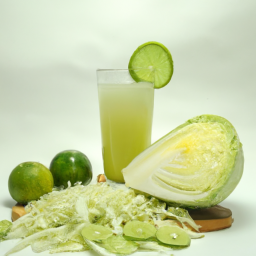As a cooking enthusiast who loves to experiment with different flavors in the kitchen, I often reach for a lime to add a tangy touch to my dishes. But have you ever thought about how much juice you can get from just one lime?
It’s a question that I’ve asked myself many times, and I’ve done some research and experimentation to find the answer. In this article, I’ll be sharing my findings and insights on the topic of how much juice one lime yields.
We’ll explore the different types of limes and factors that can affect juice yield, as well as tools and techniques for juicing limes and measuring the juice. I’ll also share some tips and tricks for getting the most juice out of your limes, and even some alternative sources of lime juice that you can use in a pinch.
So, let’s get started and learn all about the wonderful world of lime juice!
Key Takeaways
- Lime juice yield is affected by factors such as ripeness, size, and method of extraction.
- Plump, heavy, and bright green limes are preferable for juicing, and rolling them can maximize juice yield.
- Electric citrus juicers are efficient for making large batches of lime juice, while handheld juicers are small, affordable, and easy to use.
- Accurate measurement of lime juice is important in cooking and baking, and it can be stored in a glass container with a tight-fitting lid, or frozen/refrigerated for later use.
Understanding the Different Types of Limes
You may think all limes are the same, but did you know that there are actually several different types, each with their own unique flavor profile and uses in cooking and cocktails?
The most common type of lime is the Persian or Tahiti lime. It is the lime you find in most grocery stores and is what many recipes call for. Persian limes are larger and less acidic than other types of limes, with a bright green skin and juicy flesh. They have a tart, tangy flavor and are commonly used in cocktails like margaritas and mojitos.
Another type of lime is the Key lime, which is smaller, rounder, and has a thinner skin than Persian limes. They are more acidic and have a more intense, floral aroma and flavor. Key limes are commonly used in desserts like key lime pie, but can also be used in cocktails and savory dishes.
Other types of limes include Kaffir limes, which have a bumpy, knobby skin and are used in Southeast Asian cuisine, and Rangpur limes, which are actually a hybrid of a lemon and a mandarin orange and have a tart, acidic flavor.
Understanding the different types of limes is important when it comes to determining how much juice you can expect to get from each lime. However, there are other factors that can affect lime juice yield as well, such as the ripeness of the fruit and the method used to extract the juice.
Factors Affecting Lime Juice Yield
When squeezing a lime, factors like ripeness and size can impact the amount of citrusy goodness you’ll get. Lime juice acidity is highest when the fruit is fully ripe, making it easier to extract the juice. On the other hand, unripe limes have a lower juice yield and a more bitter taste.
When selecting limes for juicing, it’s important to choose fruits that are plump, heavy, and have a bright green color. These are signs of a juicy and flavorful lime. Aside from ripeness, lime size also plays a role in juice yield. Smaller limes tend to have less juice than larger ones. However, it’s important to note that larger limes may have thicker rinds, which can make them more difficult to juice.
To maximize juice yield, it’s recommended to bring the limes to room temperature before juicing and to roll them on a hard surface to break down the cell walls. With these factors in mind, you’ll be able to get the most juice out of your limes and enjoy their tangy flavor in all your recipes.
Moving on to the next section, let’s talk about the tools you’ll need for juicing limes.
Tools for Juicing Limes
To get the most out of your lime juicing experience, it’s essential to have the right tools at your disposal. Juice extractor options like electric citrus juicers, hand-held juicers, and reamers are great choices for extracting lime juice.
Electric citrus juicers are perfect for people who want to juice limes quickly and efficiently, while hand-held juicers are great for those on a budget who want to squeeze lime juice without breaking the bank. Lastly, reamers are perfect for those who want to extract every last drop of lime juice from their fruit manually.
Hand-held juicers are some of the best tools for juicing limes. They are small, affordable, and easy to use. With a hand-held juicer, you can extract the juice from your lime in seconds, and they are perfect for people who don’t have a lot of space in their kitchen.
If you’re looking for a more high-tech option, electric citrus juicers are great for people who want to juice limes quickly and efficiently. These juicers are perfect for people who want to make large batches of lime juice for cocktails or cooking. With the right tools, juicing limes can be a quick and easy process that will allow you to get the most out of your fruit.
Now that you know about the different juice extractor options, it’s time to learn how to juice a lime properly.
How to Juice a Lime
First, it’s important to select a ripe lime for juicing, as it’ll be easier to extract the maximum amount of juice.
To juice a lime, you can start by rolling it on a hard surface, like a countertop, using the palm of your hand. This helps to break down the fibers inside the lime and makes it easier to juice.
Then, cut the lime in half using a sharp knife, and use a citrus juicer or a fork to extract the juice. You can also use a reamer, which is a tool specifically designed for juicing citrus fruits.
There are several lime juicing techniques that can help you extract the most juice from your lime. For example, you can use a spoon to scoop out the flesh of the lime after you’ve juiced it, or you can use a cloth or paper towel to squeeze out any remaining juice.
Fresh lime juice has many benefits, including being high in vitamin C and antioxidants, and it can add a bright and tangy flavor to your dishes.
With these techniques, you can easily juice a lime and enjoy the benefits of fresh lime juice in your cooking.
Now, let’s move on to measuring lime juice.
Measuring Lime Juice
When it comes to measuring lime juice, there are a few different methods you can use. Personally, I like to use a juicer to extract the juice from the lime before measuring it out. This ensures that I get the most juice possible without any pulp or seeds.
Alternatively, you can also measure the juice using a measuring cup or kitchen scale, depending on your preference and the recipe you’re making.
Using a Juicer
Simply pop a lime into the juicer, and in no time, you’ll have freshly squeezed juice that’s perfect for your recipe. Using a juicer is the easiest and most efficient way to extract the maximum amount of juice from a lime. Here are some tips that I’ve learned from my experience of using a juicer:
-
Choose an electric juicer over a manual one. While manual juicers may be cheaper, they require more effort and time to use, and often don’t extract as much juice as an electric juicer does.
-
Cut the lime into halves or quarters before juicing. This makes it easier for the juicer to extract the juice and prevents the lime from getting stuck in the juicer.
-
Clean the juicer thoroughly after each use. Lime juice can be acidic and corrosive, and if left in the juicer for too long, it can damage the machine.
-
Store the lime juice in a glass container with a tight-fitting lid. This will prevent the juice from absorbing any unwanted flavors in the fridge.
Now that you have your freshly squeezed lime juice, the next step is to measure it accurately for your recipe.
Using a Measuring Cup
To accurately measure your freshly squeezed lime juice for your recipe, you’ll need a measuring cup that’s marked with both ounces and milliliters. Measuring accuracy is crucial when it comes to cooking and baking, especially when it comes to acidic ingredients like lime juice.
Using a measuring cup not only ensures that you have the right amount of juice for your recipe, but it also helps you avoid over- or under-seasoning your dish.
While using a juicer is a quick and easy way to extract lime juice, it may not provide the most accurate measurement. Alternative methods like using a fork or a citrus reamer may also not give you precise measurements. That’s why using a measuring cup is the best way to ensure that you have the right amount of lime juice for your recipe.
However, if you prefer to use a different method, the next subtopic will discuss how to measure lime juice using a kitchen scale.
Using a Kitchen Scale
Precision is paramount when weighing your portions of lime for your recipe, so grab your kitchen scale and get ready to measure with meticulousness. Measuring accuracy is crucial to ensure that you achieve the perfect balance of acidity in your dish.
Using a kitchen scale allows you to be as precise as possible when measuring your lime juice. When using a kitchen scale, it’s important to convert the units properly. Most recipes call for lime juice in tablespoons or teaspoons, so you’ll need to convert the weight of the lime to its equivalent volume. One medium-sized lime typically yields about 2 tablespoons or 6 teaspoons of juice. However, this can vary depending on the size and ripeness of the lime.
By using a kitchen scale, you can ensure that you’re using the correct amount of lime juice for your recipe. Moving on to the subsequent section about storing lime juice, it’s important to note that there are different methods for preserving lime juice depending on how long you need it to last.
Storing Lime Juice
Storing lime juice can be tricky, but with the right technique, you can keep it fresh for a week. Freezing lime juice is one way to preserve it for a longer period, but it may change the taste and texture of the juice. If you choose to freeze your lime juice, make sure to store it in an airtight container and leave some space at the top to allow for expansion as it freezes.
Another way to store lime juice is to keep it in the fridge. Use a clean, airtight container and make sure to remove any air pockets before sealing it. This will prevent the juice from oxidizing and going bad quickly.
When you’re ready to use the juice, give it a good shake to mix any settled pulp back into the liquid. With proper storage, your lime juice will be ready to use in your favorite recipes.
Using lime juice in recipes can add a bright, tangy flavor to dishes. From marinades to cocktails, lime juice can be a versatile ingredient in the kitchen.
To get the most out of your lime juice, make sure to use fresh, ripe limes and store the juice properly.
Using Lime Juice in Recipes
When it comes to using lime juice in recipes, I find that it’s a versatile ingredient that can add a refreshing twist to cocktails, marinades, dressings, and sauces.
In cocktails, lime juice can provide a tangy and zesty flavor that pairs well with a variety of spirits.
In marinades, it can help tenderize meat while adding a citrusy kick to the flavor profile.
And in dressings and sauces, lime juice can provide a bright and acidic element that balances out other ingredients.
Cocktails
If you’re feeling adventurous, add a squeeze of lime to your cocktail for a zesty kick that will transport your taste buds to a tropical paradise. Lime juice is a popular ingredient in many classic cocktails, including margaritas, mojitos, and daiquiris.
Not only does it add a refreshing flavor, but it also helps balance out the sweetness of the alcohol. For an extra touch of flair, try using lime wedges as cocktail garnishes.
If you don’t have fresh limes on hand, there are some lime juice substitutes you can use. Bottled lime juice is a convenient option, but be sure to check the label for any added preservatives or sugars. Another alternative is to use lemon juice or vinegar, which can provide a similar level of acidity to lime juice.
Now, let’s move onto the next section about marinades.
Marinades
Marinades are a perfect way to infuse flavor into your meat or vegetables, creating a mouth-watering dish that will leave your taste buds begging for more. By combining different flavor combinations, you can create a unique and delicious marinade that will take your dish to the next level.
Some popular flavor combinations include citrus and herbs, soy sauce and ginger, or honey and mustard. In addition to flavor, marinades can also be used to tenderize meat. Certain ingredients like vinegar or pineapple juice contain enzymes that break down the protein in meat, making it more tender.
Other tenderizing techniques include using a meat mallet or piercing the meat with a fork before marinating. With the right combination of flavors and tenderizing techniques, your marinade can turn even the toughest cut of meat into a succulent and juicy masterpiece.
Now, let’s move on to dressings and sauces to complement your dish.
Dressings and Sauces
Moving on from marinades, let’s dive into dressings and sauces. As someone who loves to experiment with flavors in the kitchen, dressings and sauces are my go-to for adding creative flavor combinations to any dish. Not only do they enhance the taste of a meal, but they also provide some health benefits depending on the ingredients used. For example, a homemade vinaigrette made with olive oil, vinegar, and herbs can provide healthy fats and antioxidants, while also adding a tasty kick to your salad.
To help you get started on your own dressing and sauce creations, I’ve put together a table with some simple yet delicious recipes. Each recipe highlights a different main ingredient, such as avocado or yogurt, and shows how easy it can be to whip up a flavorful dressing or sauce at home. Don’t be afraid to play around with the ingredients and make it your own! With some experimentation, you might just discover your new favorite dressing or sauce.
Now, let’s move on to the next section where we will discuss some tips for getting the most juice out of your limes.
Tips for Getting the Most Juice Out of Your Limes
By using a simple kitchen tool and a bit of elbow grease, you can extract every last drop of juice from your limes, making your dishes burst with citrus flavor. Here are some tips for getting the most juice out of your limes:
-
Roll the lime on a hard surface before cutting it in half to help break down the membranes and release more juice.
-
Microwave the lime for 10-15 seconds before cutting it to soften it and make it easier to squeeze.
-
Use a citrus reamer or juicer to extract the juice, rather than just squeezing it with your hands.
-
Cut the lime lengthwise instead of crosswise to expose more of the fruit and get more juice.
It’s important to note that lime storage and freshness can also affect how much juice you get from your limes. If your limes are too dry or old, they may not produce as much juice. If you don’t have fresh limes on hand, you can also use alternative sources of lime juice, such as bottled lime juice or other citrus juices.
Alternative Sources of Lime Juice
If you’re in a pinch and need a quick citrus boost for your recipe, you can easily grab a bottle of pre-squeezed lime juice from the grocery store. However, it’s important to note that there are some differences between fresh lime juice and bottled lime juice. Fresh lime juice is always preferred because it contains more nutrients and has a better taste. Bottled lime juice may contain added preservatives and sugars, and it doesn’t have the same level of freshness as freshly squeezed lime juice.
To compare the nutritional benefits of fresh and bottled lime juice, here is a table outlining the differences in vitamin C content:
| Fresh Lime Juice | Bottled Lime Juice | |
|---|---|---|
| Vitamin C | 30 mg | 24 mg |
As you can see, fresh lime juice contains more vitamin C than bottled lime juice. This is because the longer lime juice sits in a bottle, the more it loses its nutritional value. So, if you want the most nutritional benefits and best taste, it’s always recommended to use fresh lime juice in your recipes.
Frequently Asked Questions
Can lime juice be substituted for lemon juice in recipes?
When it comes to Lime vs Lemon, there are distinct Flavor Differences. However, lime juice can often be substituted for lemon juice in recipes with a similar result. Cooking Tips: How to Get More Juice from Limes include microwaving them for a few seconds before squeezing.
How long does lime juice stay fresh in the refrigerator?
I store lime juice in the refrigerator for up to two weeks to ensure its freshness. The key to preserving its taste is to use an airtight container and avoid exposing it to light and heat.
Does the ripeness of a lime affect the amount of juice it yields?
As a lime enthusiast, I’ve noticed that the ripeness of a lime can definitely impact the amount of juice it yields. Additionally, proper lime storage can extend its lifespan and juice potential.
Can lime juice be frozen for later use?
Yes, lime juice can be frozen for later use using various freezing techniques. There are many lime juice recipes that call for frozen juice. It’s important to store it properly and defrost it before use.
Are there any health benefits to drinking lime juice?
Drinking lime juice has numerous health benefits, such as aiding in digestion and boosting the immune system. It can also be used in various recipes, from marinades to cocktails, for a zesty flavor.
Conclusion
Well, that was quite an adventure! I can now confidently say that I know exactly how much juice one lime yields.
Through my research, I discovered that the type of lime, its ripeness, and the juicing method all play a role in determining how much juice you’ll get. But what really stuck with me was the importance of getting the most juice out of your limes.
It’s like squeezing every last drop of potential out of a situation, just like I did with my limes. It’s a reminder to make the most of what we have, and not waste anything.
So next time you’re juicing limes for a recipe, make sure to use the right tools, follow the tips, and squeeze every last drop. Who knows what other opportunities in life we can do the same with?
Ilana has been a vegan for over 10 years. She originally made the switch for health reasons, but soon found herself becoming more and more passionate about the ethical and environmental implications of a vegan lifestyle. Ilana is the author of The Graceful Kitchen, a blog all about veganism. She loves to cook up delicious and nutritious vegan meals, and share her recipes with others who are interested in leading a cruelty-free life. Ilana is also a strong advocate for using whole foods as the foundation of a healthy diet, and believes that going vegan is one of the best ways to achieve this.










